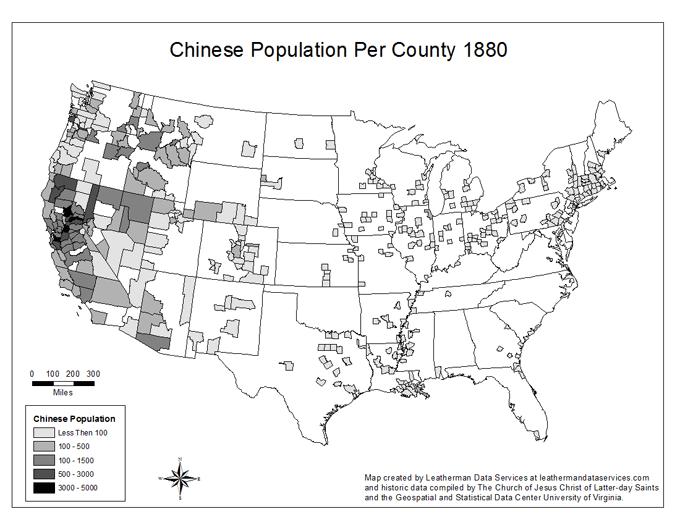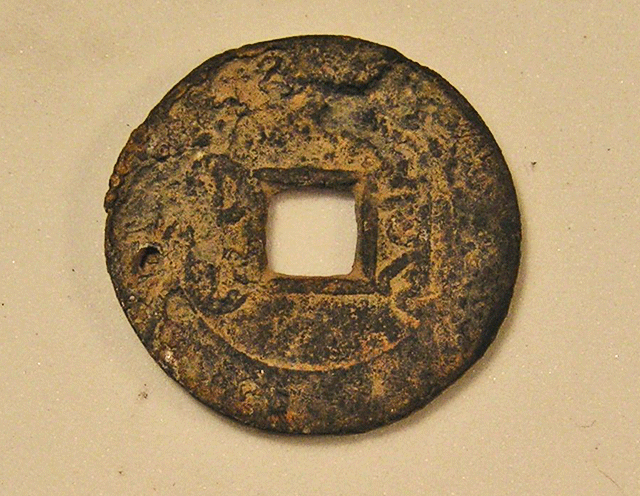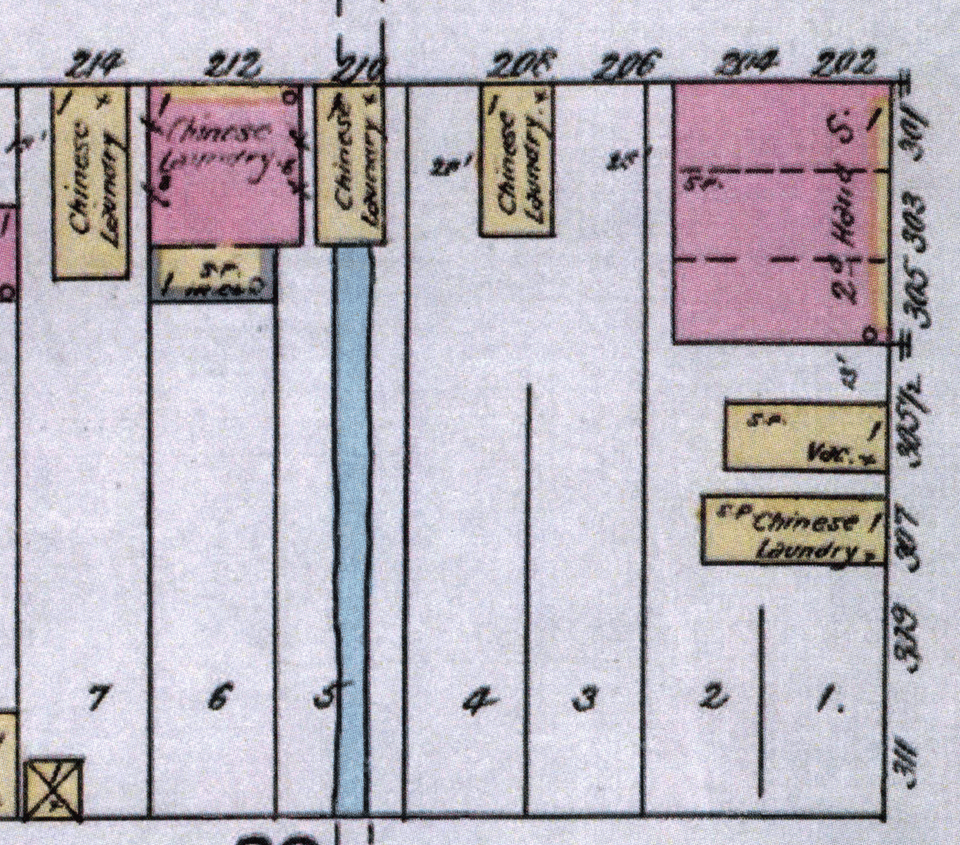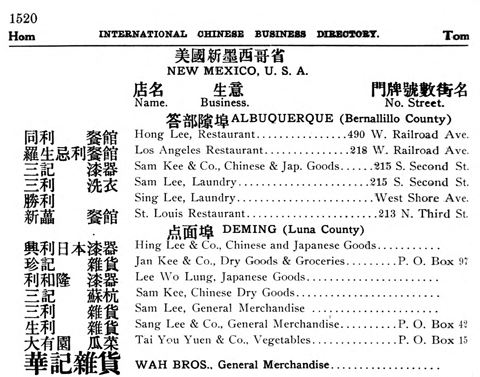
The Chinese in the U.S. in 1880. Map courtesy Leatherman Data Services. For a larger version of the map, please click here
The term "Chinese Diaspora" refers to the spread of Chinese people and their culture throughout much of the world. Here we focus on the United States and in particular on New Mexico.
To see a YouTube video on the Chinese of New Mexico, based on studies by Maxwell Museum research associate Dr. Anna Naruta-Moya, please click on the "play" button.
In the mid-1800s, the Chinese joined the swell of migration into the United
States. Many Chinese intended to return to China after making money in
"Gold Mountain" (as they called the U.S.). Moreover, popular prejudice and
anti-Chinese laws ensured that the new migrants were mostly confined to
menial jobs—for example, as railroad or laundry workers. Even so, many
Chinese chose to make a new life in the United States, and their descendants
are now part of the ethnic stew we call America.
The flow of Chinese into the U.S. was through West Coast ports and as the map
below shows, most of the migrants never made it more than a few hundred miles
inland. Nonetheless, by 1880 there were scattered pockets of Chinese immigrants
across the country. Some, such as railroad workers, camped wherever their work
took them. Others settled in cities and became the nucleus of
"Chinatowns." In smaller towns, such as those
in New Mexico, the Chinese simply fit in where they could. Usually that meant having
homes and businesses in more ragged neighborhoods, where rents were cheaper
and ethnic diversity was more tolerated.

The Chinese in the U.S. in 1880. Map courtesy Leatherman Data Services.
For a larger version of the map, please click
here
The use of Chinese labor in 1800s railroad construction is well known.
Few traces have been found of the Chinese who helped build New Mexico's railroads,
but the coin shown below is one of the exceptions. It was found during an
archaeological study next to railroad lines near Deming, and presumably was
dropped by a Chinese laborer.
reference

A Chinese coin found along New Mexico's railroad lines. Photo courtesy
TRC, Inc.
A different archaeological study, along the railroad line leading northwest out of El Paso, found the remains of a camp made by Chinese railroad workers. This camp yielded two coins similar to the one shown above; the two coins were identified as 1 wen coins struck between 1862 and 1875. Other items that indicated a Chinese presence included fragments of rice bowls, a fragment from a stoneware vessel imported from China, an opium can and two opium can lids, and fragments of possible opium pipes. One can of opium had been manufactured in China but two had been manufactured in British Columbia. reference
While some Chinese workers moved on after each stretch of railroad was completed, others found work in local towns. John Wunder reports that by 1880, one out of every 100 persons living in the Southwest was Chinese. He also notes how in some towns the Chinese encountered outright hostility. When two Chinese men tried to claim a lot in Deming in 1888, an Anglo-American resident assulted them with a club. The solution proposed by the September 22, 1888 Deming Headlight was for a non-Chinese to buy the lot—eliminating the possibility that the Chinese could live there. In the face of such hostility, the Chinese congregated in New Mexico towns where they were at least tolerated—Albuquerque, Las Vegas, Raton, and Silver City among them. A neighborhood where Chinese congregated invariably became known as a "Chinatown," even if it was multi-ethnic.reference
The next map shows where a few of Albuquerque's Chinese were living in 1898.
It is part of a fire insurance map with individual lots and buildings, and shows
the southwest corner of Silver Avenue (top of the image) and Second Street
(right edge of the image). Chinese laundries are shown at 208, 210 1/2, 212, and
214 Silver Avenue and at 307 Second Street. (A large second-hand store is
present on the corner of the block, and there is a vacant building at 305 1/2
Second Street.) The laundries usually also served as residences.
Based on an 1897 city directory, we know the names of the Chinese who lived
or worked (or both) on this block: Chong Lee, Jim Lee, Joe Lee, Chong Sing,
Look Sing, Sam Sing, and Wing Wah.
reference

Chinese laundries on the corner of 2nd Street and Silver Avenue,
Albuquerque, 1898
Laundry work was a low-status occupation and customers rarely had any contact with the block's Chinese residents other than to drop off or pick up laundry. Still, the work placed the new immigrants on the first rung of the economic ladder, and the presence of other Chinese in Albuquerque meant that new arrivals did not live in a social vacuum.
Archaeology can provide glimpses of daily life for the early immigrant Chinese, by showing what goods those immigrants were consuming. Unfortunately, thus far we don't have extensive evidence from Chinese neighborhoods in New Mexico. We can get some idea about life in those neighborhoods by looking at a study of El Paso's Chinatown, which was 16 miles south of the New Mexico state line.
A private web site offers glimpses of the Chinese-Americans of Silver City. One story on that page dsecribes how a local cafe owner, Yat Lim, was killed by two "Anglos" in 1945. Neither was convicted.
A different murder—in Las Vegas, New Mexico in 1882—led to a landmark court case, Territory of New Mexico v. Yee Shun. The case established that Asian-Americans were entitled to testify in a court of law, something we take for granted today. You can read about the court case here.
In 1913, a company based in San Francisco published an international directory
of Chinese-owned businesses, including two pages of businesses in New Mexico. You can see the New Mexico entries in the directory by clicking on the photo below.

Click on the photo to see the directory entries
Many individuals in the "first wave" of Chinese immigration, in the 1800s, returned to China. Many had come here with the intention of returning. Others bowed to anti-Chinese hostility, which became encoded in state and federal laws and made it difficult for male Chinese workers to bring over spouses and start families. Many of New Mexico's Chinese-Americans are instead descended from a "second wave" of immigrants that began in the early 1900s. While U.S. immigration law was designed to keep Chinese out, a 1915 court case led to an exception involving Chinese restaurants. The result was an explosive growth in Chinese restaurants, as enterprising invididuals obtained coveted visas for themselves and for family members. (You can learn more about that restaurant boom here.) Most early 1900s immigrants were from Guangdong province in southern China and until the late 1900s, most Chinese restaurants in the U.S. featured that province's cooking (known as Cantonese) exclusively.
The "second wave" of immigration was reinforced by
the increased U.S. presence in eastern Asia during and
after World War II—it continues to this day.
Right after World War II, some GIs brought home Chinese-born war brides.
Following the communist takeover in 1949, others found refuge in the U.S.
Many of New Mexico's Chinese-Americans were born in
Taiwan, reflecting the political and economic ties between that
island nation and the U.S. With normalization of relations between the
U.S. and China, still others have come to this country from the Chinese
mainland. Today, New Mexicans of Chinese descent are a diverse mix
ranging from long-established U.S. families to individuals who arrived
almost yesterday.
See source code for copyright information. Page last revised on January 5, 2018. Please report problems to toh@unm.edu